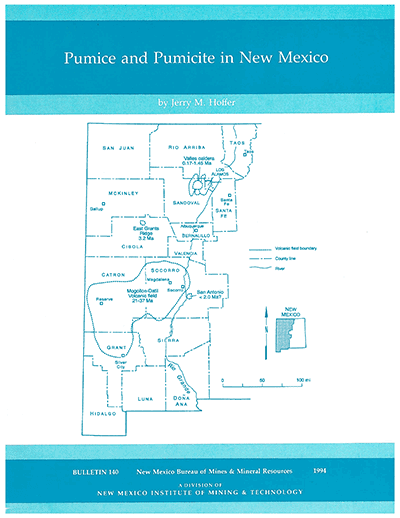
Bulletin 140—Pumice and Pumicite in New Mexico
By J. M. Hoffer, 1994, 23 pp., 14 tables, 16 figs., 2 appendices.

NM has ranked in the top three states in the production of pumiceous materials in the U.S. since 1980. The principle domestic uses of pumice and pumicite include concrete admixtures and aggregates, building blocks, abrasives, laundry use (stone- and acid-washed denim), and landscaping. Physical properties of NM pumice and pumicite are used to determine their usefulness in the laundry industry. The principal pumiceous deposits in NM occur within the volcanic units related to the resurgent Valles caldera in the Jemez Mountains. Physical properties of the NM pumiceous materials indicate they are suitable for use in concrete aggregate, in Portland-pozzolan cements, and as abrasives. The coarse-particle pumice of the El Cajete Pumice is the most promising for laundry use.
Pumice and pumicite are pyroclastic materials produced by the rapid expansion of dissolved gases in a viscous siliceous magma generally ranging from rhyolite to dacite composition. This group of pyroclasts is distinctive because they are glassy and consist of a cellular structure composed of numerous thin-walled vesicles. Pumicite originates when dissolved gases in the viscous magma produce a froth or a large quantity of bubbles in a short period of time followed by rapid rupture of the vesicles. If fewer bubbles develop in the magma, and the glass vesicle walls are allowed to solidify rapidly enough to prevent collapse, then pumice will form. An academic classification of pyroclastics and pumiceous fragments, which defines the fragments upon size, is given in this bulletin.
Block pumice has commonly been used to refer to lump pumice; however, the term block has been defined legally as a pumice fragment possessing dimensions equal to or exceeding 50.8 mm. The laundry industry utilizes only coarse pumice ranging from 19 to 76 mm in diameter; fragments smaller than 19 mm would disintegrate completely before the completion of the 15 to 50 min washing cycle. The proportion of coarse pumice in a typical pumiceous deposit is generally less that 10%. A survey of 58 deposits in the western U.S. shows that more than 30% contain no pumice fragments sized greater than 19 mm. The average percent of fragments greater than 19 mm for all of the deposits is 7.3%.
Pumice materials are formed in areas of explosive volcanism where high-silica materials have erupted. Such areas occur in the western U.S. and include the active volcanoes of the Cascade Mountains in northern CA, OR, and WA. In addition, numerous deposits have been produced from siliceous calderas and volcanic dome complexes in CA, NV, AZ, NM, and ID. All glasses are amorphous and are therefore unstable in nature over geologic time if in the presence of water. Pumice and pumicite, which are natural glasses, are susceptible to alteration by chemical weathering at the earth's surface. Weathering of the pumice will devitrify the glass, form clay materials, and destroy the physical properties that make the pumice useful as an aggregate and abrasive. Therefore, fresh, unaltered pumice and pumicite are generally restricted to strata of late-Tertiary to Quaternary age or to older strata that has escaped alteration.
$5.00
Buy
Now
Also available as a free download.
Download
| File Name | Size | Last Modified |
|---|---|---|
| B140.pdf | 3.50 MB | 01/15/2021 01:24:25 PM |



